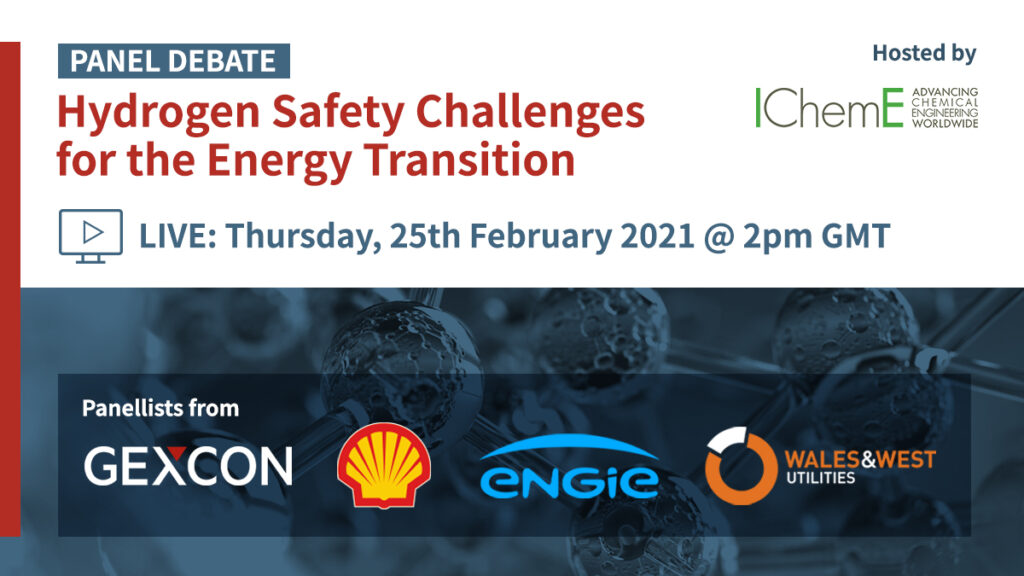
The need for an alternative sustainable energy carrier that could contribute to reducing CO2 emission arises due to significant concerns in fuel scarcity and global warming. Among many others, hydrogen is seen to potentially address these issues, resulting in its changing applications from a component in industrial processes to an energy vector. However, because this application is relatively new, the industry faces challenges in the implementation especially concerning its safety aspect.
The optimal application of hydrogen as alternative energy can only happen if questions on its safety aspect have been answered. As we know, most of the available design guidelines and engineering tools are made for hydrocarbon processes and have not yet been fully adjusted to address hydrogen hazards. This fact shows that there are gaps in the knowledge preventing us to move forward.
As a part of the “Hydrogen Safety Challenges for the Energy Transition” Panel Debate, we are interviewing the panellists to know their thoughts on hydrogen safety challenges before the event.
Lee Phillips, the Senior Technical Safety Engineer at Shell, has more than 25 years of experience within Shell’s Major Hazards group. He is currently supporting Shell’s hydrogen business, where he has developed an internal R&D program to better understand hydrogen safety and support Shell’s energy transition program. Externally Lee sits on the advisory boards and steering committees of several multi-national Joint Industry Projects, including EU-funded projects.
In this interview, Lee shares his insights on the knowledge gaps in hydrogen safety that need to be addressed to fully utilize it as an energy vector.
Q: Can you briefly describe the knowledge gaps in hydrogen safety that need to be addressed?
Lee: It is fair to say that within the traditional energy industry, many of the advances in safety engineering have been driven by major incidents: Flixborough, Piper Alpha, and Buncefield, to name a few.
Despite the scale of these incidents, they involved an energy sector that had already been accepted and adopted by society for decades.
By comparison, the hydrogen energy industry is in its infancy, and a similar incident here could damage public confidence – ask people about H2 for transport, and even today, the Hindenburg is mentioned!
To avoid incidents occurring, we need to facilitate safe designs, which requires robust understanding of the risks associated with H2 operations and effective codes and standards.
Although industry has been handling H2 safely for years, the change in application, increasing scale and usage, and bringing H2 into the public arena brings new challenges.
Although many aspects are well understood, there are several knowledge gaps: from understanding the behavior of H2 following release in different environments (e.g. enclosed or congested spaces), dispersion characteristics, the explosion properties and the threshold for transition to DDT, and potentially novel phenomena, such as condensation of atmospheric oxygen. It is essential to identify and address these knowledge gaps to feed into the relevant codes and standards, develop safe engineering solutions, and enable the adoption of the technology.
Q: You have been involved in JIPs. How would they fill in the knowledge gaps?
Lee: The JIPS are extremely important in filling the knowledge gaps.
They draw together partners from many different backgrounds: energy companies, research laboratories, model developers, regulatory authorities, academia, and many more. This diversity brings in lots of valuable expertise and experience
Personally, I have found that all partners within the JIPs are very open as they recognize that we are all working to the same goal. There is a considerable amount of knowledge sharing where companies can consolidate existing knowledge. This enables us to fill the gaps more effectively and consistently than by working separately, which may result in multiple conflicting answers.
Q: How do you see Shell’s role going forward in filling in these gaps to promote a safe hydrogen industry?
Lee: Shell has a goal of being a net-zero emissions energy business by 2050 or sooner, and H2 is seen as one way of achieving this goal.
As a leading energy company, Shell is committed to safety. As we invest heavily in H2 technology and projects worldwide, it is crucial to understand the risks associated with it to design and operate safely.
As an owner/ operator involved in the scaling up of hydrogen technology, we understand first-hand the challenges. We can bring the vast experience and expertise we have gained from similar energy carriers, such as LNG, to Hydrogen and support the rapid growth the industry requires.

A more detailed discussion between Lee and the other experts from Gexcon, Engie, and Wales & West Utilities was presented in the “Hydrogen Safety Challenges for the Energy Transition” Panel Debate. To request a replay, please click on the button below.
Do you like what you read?
Get the latest trends in the field of process safety management straight to your inbox, and enhance your skills through knowledge sharing from industry experts.



